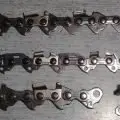You may work for longer lengths of time with a chainsaw that has been well maintained, which effectively reduces any needless strain on both you and the chainsaw. Because of the saw’s well-maintained chain, cutting through the wood will be easy.
The chain will eventually grow blunt and dull, whether you are a skilled woodworker or just gathering wood for your house fire. A dull chain requires more work and time for the cutting teeth to complete their task. Given the wide range of sizes and angles (pitch) of chainsaw blade teeth, choosing the proper chainsaw file size can be difficult. Learn more about sawmill blades in our ultimate guide!
You can find out more about utilizing a fast Oregon chainsaw file size chart to identify the chainsaw file sizes you require in this article. If you don’t know the chain size, you can also find this with the aid of the chainsaw depth gauge chart provided.
Table of Contents
- What Size Chainsaw File Do I Need?
- Understanding Chainsaw Tooth Types
- Types of Chainsaw Files
- Different Chainsaw Files and Gauges
- Chainsaw File Kits
- How to Choose the Correct File Size for My Chainsaw Chain
- How to Sharpen a Chainsaw Chain
- FAQs (Frequently Asked Questions)
What Size Chainsaw File Do I Need?
Here’s how to figure out the chainsaw chain’s file size. Look at the number stamped on the side of the chainsaw’s cutter to determine the proper file size. You then contrast that number with the file size listed on the Stihl chainsaw file sizes chart. Learn how to sharpen a chainsaw chain in our guide!
Chainsaw File Sizes Chart
For the chain you are sharpening, get the appropriate round file. How do you know, though? You’ll need the chain’s pitch or its identification number. You can determine file size with the aid of the file chart below.
| Chain Type | File Size (mm) | File Size (inches) |
|---|---|---|
| 25, 91 | 4.0 | 5/32 |
| 90 | 4.5 | 11/64 |
| 20, 21, 22, 95 | 4.8 | 3/16 |
| 16, 18, 26, 27, 72, 73, 75 | 5.5 | 7/32 |
The file chart illustrates the various chain kinds and sizes, as you can see. For accurate results and optimal sharpness, the file size must coincide with the depth gauge code number or the chain pitch, which is often between three rivets.
| Chain Pitch | File Size (mm) | File Size (inches) |
|---|---|---|
| 1/4″ | 4.0 | 5/32 |
| 0.325″ | 4.8 | 3/16″ |
| 3/8″ | 5.5 | 5/32 or 7/32 |
| 0.404″ | 5.5 | 7/32 |
Always refer to the chain’s manufacturer’s guidelines because they can specify using a different tool size than what is described in the tables above.
Alternatively, you could figure out the pitch of the chain. The pitch is measured in inches. Measure the space between the first three rivets in millimeters. The distance between the first rivet’s center and the third rivet’s center is divided by two. Add 0.039 to the value to get the result in inches. The right file can then be located using the chart.
Measuring Pitch
The measuring pitch is the distance between tooth rivets multiplied by 2.
Chainsaw Chain Pitch
Use the file chart to locate the correct file after determining the cutter’s pitch. It’s important to keep in mind that if two chain cutters aren’t the same type, even though they have the same pitch, they may need different files.
For instance, depending on the cutting edge, a chisel cutter’s square cutting edge requires the usage of a flat file. If the cutter is a chipper, a round file is necessary. When filing the cutter, only use round files to sharpen the top and side plates. The depth gauge should only be filed with a flat file to preserve its shape.
Understanding Chainsaw Tooth Types
A specific chain can be sharpened using just one file. The manual that comes with your chainsaw will provide instructions on how to select the right file and gauge.
However, if you don’t have your handbook, you’ll need to read on and understand this guide to chainsaw file sizes. You must first understand the chainsaw’s cutting mechanism to better understand why each chainsaw has a distinctive file.
The chain link that actually cuts is called the cutter. Until you reach the markers, you can sharpen your chains. Once the cutter has worn down to a specific depth, you must replace it. The three most common types of cutter teeth are chipper, chisel, and semi-chisel. Moreover, right-hand and left-hand cutters can be found on a chain. Together, these enable your chainsaw to cut wood effectively with consistency.
Round Tooth or Chipper Tooth
The chipper cutter is the simplest and most versatile file of the three. Compared to the chisel cutter, it is more resistant to dust and dirt. You can file it using a file and a guide. If you need a chin that cuts smoothly, the chipper cutter with a curved end view is a suitable choice.
Chisel
The chisel cutter is a powerful cutter that should only be used by experienced woodworkers. The chisel cutter enables commercial timber harvesting. It has an end that is squared off. To file the cutting edge, you must have a file that fits the cutting edge’s square shape. It is impossible to sharpen the chisel cutter using the file as a guide.
If the chisel has a round ground, you can file it with a round file. However, when used in a dirty or dusty environment, the chisel-cutting tool loses its edge more quickly.
Semi-Chisel
A softer form of the chisel is the semi-chisel. You’ll need a circular file with a guide to file it. Compared to the other two cutters, it maintains its sharpness longer and is more dust and grime-resistant.
Types of Chainsaw Files
Chainsaw files come in a variety of shapes, each with a specific use. The chainsaw file you choose will depend on the work at hand. There are numerous varieties of chainsaw files available, which include:
- Brass files
- Carbide files
- Diamond files
- Steel files
Brass Files
These strong, adaptable saws work well for shaping, finishing, and honing. Use them to remove rust from larger objects, such as chainsaw handles. This is so that they can reach into the confined spaces on your chainsaw’s teeth without wearing down as quickly as carbon steel saws do. Brass saws are strong and flexible enough to do this.
A brass saw’s only drawback is that it will scratch your chain more severely than a metal file. Use a leather or cloth strip to wipe the chainsaw file and another cloth to cover the chain to prevent this from happening. This prevents the metal from being scratched by particles.
Carbide Files
Chainsaw teeth may be shaped with these files because they remove material rapidly and leave a perfect finish. Additionally, using carbide files is low-pressure, which makes them perfect for repairing the teeth on your chainsaw.
Although significantly more durable and long-lasting, carbide files are just as hard as diamond files. Comparatively expensive compared to other chainsaw files, carbide files should only be used to form the chainsaw teeth and not to remove rust or oil.
Diamond Files
These coated files are excellent for polishing metal. These files also remove material quickly, making it possible to use your chainsaw’s teeth more quickly than with a standard file. Diamonds are 10 times tougher than steel, so using diamond files to remove rust from chains should be done with caution.
Steel Files
These massive steel files have an oil coating to stop rust. They are excellent at refining and reshaping chainsaw teeth. By eliminating burrs and chips, steel files can also be used to preserve the condition of your tools. They maintain well-kept, ready-to-use tools. Steel files can be used to remove oil or rust from many surfaces in your garage, including the engine of your chainsaw and any spanners you use with it.
Different Chainsaw Files and Gauges
There aren’t many alternatives when determining what file size I need for my chainsaw, but they do matter.
Chainsaw File Size
There are three main file sizes: 4 mm, 4.8 mm, and 5.5 mm. These might be flat files or round files, depending on the type of cutter you’re sharpening. If your chain has a chipper cutter, you’ll need to use a circular file. A 5.5 mm round file will be produced if the cutter’s pitch is 5.5 mm.
The chain will require a flat file if it has a chisel cutter. If the chisel cutter’s pitch is 5.5 mm, for instance, you’ll use a 5.5 mm flat file, and so on.
Flat File and Gauge
You use the gauges to set the appropriate depth gauge and check the cutter length top plate angle before filing. There are four different sizes available: 0.050, 0.058, 0.06, and 0.63 inches, respectively.
The depth gauges should not be filed to a depth of less than 0.025 inches. This is so that the chain’s depth of cut may be determined by the depth gauge on the cutter. The gauge used most frequently is 0.050 inches. The chain’s service life will be shortened if they are filed lower than that. The depth gauges should be uniformly filed across the gauge, though. If you don’t, the chain will vibrate and cut sharply or unevenly.
Gauge Measurement
The gauge measurement is typically visible on the chainsaw’s guide bar. Using the displayed number is advised over manually measuring the gauge size. Measure the gauge with calipers if you can’t find the marking.
Chainsaw File Kits
If you don’t already have a chainsaw file kit, you’ll need to get one. Some of the essential tools, such as the following, have already been mentioned:
- Using a circular file, sharpen the cutters’ cutting edges. The cutter must have a diameter that corresponds to this; the most popular diameters for home saws are 5/32″, 3/16″, and 7/32″.
- By maintaining the round file’s depth at the same level throughout filing, a file guide guarantees uniformity for each cutter.
- The length of the depth gauges must be reset using a flat file and gauge.
- Even while they are useful when sharpening in the field, a chainsaw filing vise may not be necessary if you already have a workbench and vise.
Here’s an example of an Oregon chain sharpening kit available on Amazon:
- A heavy-duty, compact, and compartmentalized case which keeps everything in place and makes it easy to find the tool you need quickly.
- Round files, flat file, file guide, depth gauge tool and file handles help you maintain your saw chain to keep it sharp and efficient.
- Chainsaw wrench and mini screwdriver help you access all parts of your saw for maintenance.
- Stump vise holds the chainsaw in place while working on your saw in the woods, creating a working bench on the stump
- Felling wedge helps you keep your bar and chain from getting pinched when making a cut and tips the tree in the right direction.
Prices pulled from the Amazon Product Advertising API on:
Product prices and availability are accurate as of the date/time indicated and are subject to change. Any price and availability information displayed on [relevant Amazon Site(s), as applicable] at the time of purchase will apply to the purchase of this product.
Safety is a priority when working with chainsaws, therefore, you should learn how to use a chainsaw safely!
How to Choose the Correct File Size for My Chainsaw Chain
- Identify Your Chain’s Pitch: The pitch is the distance between any three consecutive rivets divided by two. It’s a crucial parameter that often determines the file size. Common pitches include 1/4″, .325″, 3/8″, and .404″.
- Check Your Chainsaw’s Manual: The easiest and most accurate way to find out the recommended file size for your chainsaw chain is to consult the user manual. Manufacturers typically specify the size of the file needed for each model.
- Look at the Chain Packaging or Manufacturer’s Website: If you don’t have access to the manual, the packaging of your chain or the manufacturer’s website may also list the recommended file size.
- File Diameter is Key: The file size refers to the diameter of the round file needed for the specific chain. Common sizes include 4 mm (5/32″), 4.8 mm (3/16″), and 5.5 mm (7/32″). The correct file size matches the cutter’s diameter to ensure an efficient and accurate sharpening process.
- Use the Right File Holder: Using a file holder that matches your file size can help maintain the correct angle and depth while filing. It also helps protect the depth gauges from being filed down accidentally.
- Maintain the Correct Angle: Sharpening at the correct angle is as crucial as using the right file size. The angle is often specified in the chainsaw’s manual and is typically around 30 degrees. Some file holders include angle guides to help maintain consistency.
- Consider a Complete Sharpening Kit: If you’re unsure about the specifics or prefer an all-in-one solution, consider purchasing a chainsaw sharpening kit designed for your chain type. These kits often include files of various sizes, file holders, and guides.
- Regular Inspection and Replacement: Regularly inspect your files for wear and replace them as needed. A worn-out file won’t sharpen effectively and can damage the chain.
- Practice and Patience: Proper sharpening technique comes with practice. If you’re new to this, take your time and follow the guidelines closely to avoid damaging your chain.
- Seek Professional Advice if Unsure: If you’re still unsure about the correct file size or how to sharpen your chainsaw chain properly, it’s wise to seek advice from a professional. They can provide guidance tailored to your specific equipment and needs.
How to Sharpen a Chainsaw Chain
Safety First
- Wear Protective Gear: Use gloves and safety glasses to protect yourself from metal filings and potential chain movement.
- Secure the Chainsaw: Place the chainsaw in a vise or clamp the bar securely to prevent the chainsaw from moving while you work.
Prepare the Chainsaw
- Clean the Chain: Before sharpening, clean the chain to remove any debris, dirt, or oil.
- Identify the Starting Point: Locate the shortest cutter on the chain; this will be your starting point. If they’re all the same size, pick any cutter and mark it with a marker or chalk to remember where you started.
Choose the Correct File
- Select the Right File Size: Use the correct diameter round file for your chain’s pitch and cutter type. Refer to the manufacturer’s specifications for the correct size.
- File Holder/Guide: A file guide can help maintain the correct angle and depth while sharpening.
Sharpening Process
- Position the File: Place the file in the notch on the front of the cutter. The file should rest on the cutter and fit snugly in the gullet. The top of the file should be about 20% above the top plate of the cutter.
- Find the Right Angle: Most chains have a recommended filing angle, often between 25° to 35°. Some file guides have angle markings to help maintain consistency.
- Use Consistent Strokes: With moderate pressure, push the file across the cutter in one smooth motion away from your body. Lift the file off the cutter on the return stroke to avoid dulling the file. Generally, 2-3 strokes are sufficient for lightly dulled cutters, but severely dull cutters may require more.
- Maintain Even Sharpness: Try to use the same number of strokes and apply consistent pressure on each cutter to maintain an even sharpness across the chain.
- Switch Sides: After sharpening all the cutters on one side, move to the other side of the chain and repeat the process. This ensures all cutters are evenly sharpened.
Check and Adjust the Depth Gauges
- Depth Gauges Control Cut Depth: After several sharpening sessions, the depth gauges (the small ramps in front of each cutter) may need adjustment to ensure optimal cutting depth.
- Use a Depth Gauge Tool: A depth gauge tool and flat file can help you lower the height of the depth gauges to the manufacturer’s recommended setting.
Test the Chainsaw
- After sharpening, test the chainsaw on wood. It should cut smoothly and pull itself into the wood if sharpened correctly. If it doesn’t, it may require further sharpening or professional servicing.
FAQs (Frequently Asked Questions)
What size file does a 3/8 chainsaw chain take?
A 3/8 chainsaw chain would take a 5.5mm, 5/32-inch or 7/32-inch sized file.
What size file do I need to sharpen a chainsaw?
Simply put, the size of your chain pitch and the sort of chainsaw file you want are directly correlated. The cutting teeth will be higher in relation to the pitch as it gets bigger. As a result, the higher the teeth, the larger the file required.
What size file do you use on a .325 chainsaw chain?
A .325 inch chainsaw chain would need a 4.8mm or 3/16-inch sized file.
What size is a 4.5 mm chainsaw file?
A 4.5 mm chainsaw file is equivalent to a 11/64-inch sized file.





